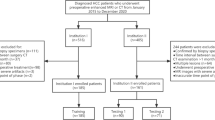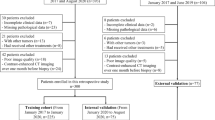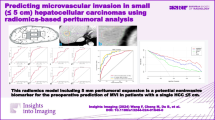Abstract
Objectives
To develop and validate a radiomics nomogram for preoperative prediction of microvascular invasion (MVI) in patients with hepatocellular carcinoma (HCC).
Methods
The study included 157 patients with histologically confirmed HCC with or without MVI, and 110 patients were allocated to the training dataset and 47 to the validation dataset. Baseline clinical factor (CF) data were collected from our medical records, and radiomics features were extracted from the artery phase (AP), portal venous phase (PVP) and delay phase (DP) of preoperatively acquired CT in all patients. Radiomics analysis included tumour segmentation, feature extraction, model construction and model evaluation. A final nomogram for predicting MVI of HCC was established. Nomogram performance was assessed via both calibration and discrimination statistics.
Results
Five AP features, seven PVP features and nine DP features were effective for MVI prediction in HCC radiomics signatures. PVP radiomics signatures exhibited better performance than AP and DP radiomics signatures in the validation datasets, with the AUC 0.793. In the clinical model, age, maximum tumour diameter, alpha-fetoprotein and hepatitis B antigen were effective predictors. The final nomogram integrated the PVP radiomics signature and four CFs. Good calibration was achieved for the nomogram in both the training and validated datasets, with respective C-indexes of 0.827 and 0.820. Decision curve analysis suggested that the proposed nomogram was clinically useful, with a corresponding net benefit of 0.357.
Conclusions
The above-described radiomics nomogram can preoperatively predict MVI in patients with HCC and may constitute a usefully clinical tool to guide subsequent personalised treatment.
Key Points
• No previously reported study has utilised radiomics nomograms to preoperatively predict the MVI of HCC using 3D contrast-enhanced CT imaging.
• The combined radiomics clinical factor (CF) nomogram for predicting MVI achieved superior performance than either the radiomics signature or the CF nomogram alone.
• Nomograms combing PVP radiomics and CF may be useful as an imaging marker for predicting MVI of HCC preoperatively and could guide personalised treatment.






Similar content being viewed by others
Abbreviations
- AFP:
-
Alpha-fetoprotein
- AP:
-
Arterial phase
- AUC:
-
Area under the curve
- CECT:
-
Contrast-enhanced computed tomography
- CF:
-
Clinical factor
- CI:
-
Confidence interval
- CT:
-
Computed tomography
- DP:
-
Delay phase
- HBsAg:
-
Hepatitis B surface antigen
- HCC:
-
Hepatocellular carcinoma
- ICC:
-
Intraclass correlation coefficient
- LASSO:
-
Least absolute shrinkage and selection operator
- LR:
-
Liver resection
- MR:
-
Magnetic resonance
- MTD:
-
Maximum tumour diameter
- MVI:
-
Microvascular invasion
- OR:
-
Odds ratio
- PACS:
-
Picture archiving and communication system
- PVP:
-
Portal venous phase
- ROI:
-
Region of interest
- RVI:
-
Radiogenomic venous invasion
- SVM:
-
Support vector machine
References
Ferlay J, Soerjomataram I, Dikshit R et al (2015) Cancer incidence and mortality worldwide: sources, methods and major patterns in GLOBOCAN 2012. Int J Cancer 136:E359–E386
Chen W, Zheng R, Baade PD et al (2016) Cancer statistics in China, 2015. CA Cancer J Clin 66:115–132
Forner A, Llovet JM, Bruix J (2012) Hepatocellular carcinoma. Lancet 379:1245–1255
Bruix J, Gores GJ, Mazzaferro V (2014) Hepatocellular carcinoma: clinical frontiers and perspectives. Gut 63:844–855
Gouw AS, Balabaud C, Kusano H, Todo S, Ichida T, Kojiro M (2011) Markers for microvascular invasion in hepatocellular carcinoma: where do we stand? Liver Transpl 17(Suppl 2):S72–S80
Clavien PA, Lesurtel M, Bossuyt PM, Gores GJ, Langer B, Perrier A (2012) Recommendations for liver transplantation for hepatocellular carcinoma: an international consensus conference report. Lancet Oncol 13:e11–e22
Huang C, Zhu XD, Ji Y et al (2017) Microvascular invasion has limited clinical values in hepatocellular carcinoma patients at Barcelona Clinic Liver Cancer (BCLC) stages 0 or B. BMC Cancer 17:58
Shim JH, Jun MJ, Han S et al (2015) Prognostic nomograms for prediction of recurrence and survival after curative liver resection for hepatocellular carcinoma. Ann Surg 261:939–946
Lei Z, Li J, Wu D et al (2016) Nomogram for preoperative estimation of microvascular invasion risk in hepatitis B virus-related hepatocellular carcinoma within the Milan criteria. JAMA Surg 151:356–363
Hirokawa F, Hayashi M, Miyamoto Y et al (2014) Outcomes and predictors of microvascular invasion of solitary hepatocellular carcinoma. Hepatol Res 44:846–853
Choi YS, Rhee H, Choi JY et al (2013) Histological characteristics of small hepatocellular carcinomas showing atypical enhancement patterns on gadoxetic acid-enhanced MR imaging. J Magn Reson Imaging 37:1384–1391
Sterling RK, Wright EC, Morgan TR et al (2012) Frequency of elevated hepatocellular carcinoma (HCC) biomarkers in patients with advanced hepatitis C. Am J Gastroenterol 107:64–74
Shim JH, Han S, Lee YJ et al (2013) Half-life of serum alpha-fetoprotein: an early prognostic index of recurrence and survival after hepatic resection for hepatocellular carcinoma. Ann Surg 257:708–717
Aerts HJ, Velazquez ER, Leijenaar RT et al (2014) Decoding tumour phenotype by noninvasive imaging using a quantitative radiomics approach. Nat Commun 5:4006
Choi ER, Lee HY, Jeong JY et al (2016) Quantitative image variables reflect the intratumoral pathologic heterogeneity of lung adenocarcinoma. Oncotarget 7:67302–67313
Braman NM, Etesami M, Prasanna P et al (2017) Intratumoral and peritumoral radiomics for the pretreatment prediction of pathological complete response to neoadjuvant chemotherapy based on breast DCE-MRI. Breast Cancer Res 19:57
Kuo MD, Jamshidi N (2014) Behind the numbers: decoding molecular phenotypes with radiogenomics—guiding principles and technical considerations. Radiology 270:320–325
Mazurowski MA (2015) Radiogenomics: what it is and why it is important. J Am Coll Radiol 12:862–866
Gillies RJ, Kinahan PE, Hricak H (2016) Radiomics: images are more than pictures, they are data. Radiology 278:563–577
Zhou Y, He L, Huang Y et al (2017) CT-based radiomics signature: a potential biomarker for preoperative prediction of early recurrence in hepatocellular carcinoma. Abdom Radiol (NY) 42:1695–1704
Yamamoto S, Korn RL, Oklu R et al (2014) ALK molecular phenotype in non-small cell lung cancer: CT radiogenomic characterization. Radiology 272:568–576
Kickingereder P, Burth S, Wick A et al (2016) Radiomic profiling of glioblastoma: identifying an imaging predictor of patient survival with improved performance over established clinical and radiologic risk models. Radiology 280:880–889
Elsayes KM, Hooker JC, Agrons MM et al (2017) 2017 version of LI-RADS for CT and MR imaging: an update. Radiographics 37:1994–2017
Friedman J, Hastie T, Tibshirani R (2010) Regularization paths for generalized linear models via coordinate descent. J Stat Softw 33:1–22
Banerjee S, Wang DS, Kim HJ et al (2015) A computed tomography radiogenomic biomarker predicts microvascular invasion and clinical outcomes in hepatocellular carcinoma. Hepatology 62:792–800
Huang Y, Liu Z, He L et al (2016) Radiomics signature: a potential biomarker for the prediction of disease-free survival in early-stage (I or II) non-small cell lung Cancer. Radiology 281:947–957
Huang YQ, Liang CH, He L et al (2016) Development and validation of a radiomics nomogram for preoperative prediction of lymph node metastasis in colorectal cancer. J Clin Oncol 34:2157–2164
Zhang B, Tian J, Dong D et al (2017) Radiomics features of multiparametric MRI as novel prognostic factors in advanced nasopharyngeal carcinoma. Clin Cancer Res 23:4259–4269
Zhou M, Leung A, Echegaray S et al (2018) Non-small cell lung cancer radiogenomics map identifies relationships between molecular and imaging phenotypes with prognostic implications. Radiology 286:307–315
Renzulli M, Brocchi S, Cucchetti A et al (2016) Can current preoperative imaging be used to detect microvascular invasion of hepatocellular carcinoma? Radiology 279:432–442
Chou CT, Chen RC, Lin WC, Ko CJ, Chen CB, Chen YL (2014) Prediction of microvascular invasion of hepatocellular carcinoma: preoperative CT and histopathologic correlation. AJR Am J Roentgenol 203:W253–W259
Bakr S, Echegaray S, Shah R et al (2017) Noninvasive radiomics signature based on quantitative analysis of computed tomography images as a surrogate for microvascular invasion in hepatocellular carcinoma: a pilot study. J Med Imaging (Bellingham) 4:041303
Rodríguez-Perálvarez M, Luong TV, Andreana L, Meyer T, Dhillon AP, Burroughs AK (2013) A systematic review of microvascular invasion in hepatocellular carcinoma: diagnostic and prognostic variability. Ann Surg Oncol 20:325–339
Lubner MG, Malecki K, Kloke J, Ganeshan B, Pickhardt PJ (2017) Texture analysis of the liver at MDCT for assessing hepatic fibrosis. Abdom Radiol (NY) 42:2069–2078
Davnall F, Yip CS, Ljungqvist G et al (2012) Assessment of tumor heterogeneity: an emerging imaging tool for clinical practice? Insights Imaging 3:573–589
Lubner MG, Smith AD, Sandrasegaran K, Sahani DV, Pickhardt PJ (2017) CT texture analysis: definitions, applications, biologic correlates, and challenges. Radiographics 37:1483–1503
Tran B, Dancey JE, Kamel-Reid S et al (2012) Cancer genomics: technology, discovery, and translation. J Clin Oncol 30:647–660
Liu C, Xiao GQ, Yan LN et al (2013) Value of alpha-fetoprotein in association with clinicopathological features of hepatocellular carcinoma. World J Gastroenterol 19:1811–1819
Du M, Chen L, Zhao J et al (2014) Microvascular invasion (MVI) is a poorer prognostic predictor for small hepatocellular carcinoma. BMC Cancer 14:38
Chen L, Zhang Q, Chang W, Du Y, Zhang H, Cao G (2012) Viral and host inflammation-related factors that can predict the prognosis of hepatocellular carcinoma. Eur J Cancer 48:1977–1987
Wei X, Li N, Li S et al (2017) Hepatitis B virus infection and active replication promote the formation of vascular invasion in hepatocellular carcinoma. BMC Cancer 17:304
Funding
This study has received funding from the CAMS Innovation Fund for Medical Sciences (CIFMS) (2016-I2M-1-001), PUMC Youth Fund (2017320010), Chinese Academy of Medical Sciences (CAMS) Research Fund (ZZ2016B01), National Natural Science Foundation of China (81227901, 61231004) and National Key R&D Program of China (2017YFA0205200, 2017YFC1309100).
Author information
Authors and Affiliations
Corresponding authors
Ethics declarations
Guarantor
The scientific guarantor of this publication is Jie Tian.
Conflict of interest
The authors declare that they have no conflict of interest.
Statistics and biometry
Jingwei Wei kindly provided statistical advice for this manuscript.
One of the authors (Dongsheng Gu) has significant statistical expertise.
No complex statistical methods were necessary for this paper.
Informed consent
Written informed consent was waived by the institutional review board.
Ethical approval
Institutional review board approval was obtained.
Methodology
• Retrospective
• Diagnostic or prognostic study
• Performed at one institution
Additional information
Publisher’s note
Springer Nature remains neutral with regard to jurisdictional claims in published maps and institutional affiliations.
Electronic supplementary material
ESM 1
(DOC 7154 kb)
Rights and permissions
About this article
Cite this article
Ma, X., Wei, J., Gu, D. et al. Preoperative radiomics nomogram for microvascular invasion prediction in hepatocellular carcinoma using contrast-enhanced CT. Eur Radiol 29, 3595–3605 (2019). https://doi.org/10.1007/s00330-018-5985-y
Received:
Revised:
Accepted:
Published:
Issue Date:
DOI: https://doi.org/10.1007/s00330-018-5985-y




